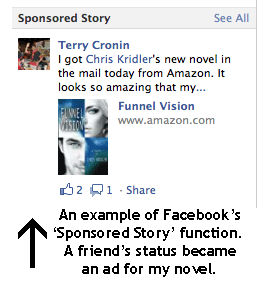Why have fans when you can have friends?
Comment on this post or share it at: Why have fans when you can have friends?
Read more great content on the Taleist self-publishing blog
 When it comes to promoting your book, social-media opportunities abound, if you don't abuse communications with followers and friends. On Facebook, striking this balance can be delicate and confusing but ultimately worthwhile.
When it comes to promoting your book, social-media opportunities abound, if you don't abuse communications with followers and friends. On Facebook, striking this balance can be delicate and confusing but ultimately worthwhile.
Facebook fan pages
Facebook's fan pages for public figures, books and businesses have the advantage of being "opt in," meaning people have to "like" your page before they see updates on it. But the opt-in process also can be a disadvantage, in that you have to market the fan page – getting as many people to "like" it as possible – before you market the book. In addition, if you feel the desire to note something on your personal account as well as the fan page, you might irk people who are friends and fans with double posts.
A fan page is a great idea if you already have a lot of readers, but for many self-published authors, that's not the case. You might consider promoting your book on Facebook as yourself.
Promoting your book on your personal Facebook page
One reason to consider this option is that now even non-friends can subscribe to your public posts on Facebook. It's a lot like following someone on Twitter. If you do post a marketing message, make sure that post is public by clicking on the drop-down menu to the left of the "post" button and choosing who will see your post.
I've seen authors accumulate many, many friends on Facebook who aren't really people they know, but that's what Facebook has become, a repository of a few close friends mingled with Facebook Friends. Facebook's new lists can help you organize them into different levels of friendship, sharing and communication.
I enjoy keeping up with friends, and I don't like to see Facebook as a promotional vehicle. Who does?
The 70/30 rule
Social media experts say promotional messages shouldn't take up more than 30 percent of your posts.
Otherwise, you start to sound like spam. You don't want friends "unsubscribing" (roll your cursor over the right side of any status and look for the dropdown menu to see options regarding that user). So when it came time to promote my novel "Funnel Vision," I tried to follow the 70-30 rule.
Since my novel is about storm chasers, and I have a ton of storm-chaser Facebook Friends, it was a no-brainer that I try to reach them. I started with a blog post about why I'd decided to self-publish, so I could link to actual content. Then I posted a short, stormy book trailer. The reaction was overwhelmingly positive, so I knew I'd reached at least a few of the people who might be interested. A few days in advance of my book launch, I announced a book page on my web site.
Here's where it got interesting. It was clear from following the shares and comments that because of Facebook's lists feature, I was not reaching all of my Facebook Friends.
Just because you have 700 friends doesn't mean 700 people are reading your posts.
At any moment, your friends might just be watching posts by their Close Friends, people in their geographic area, or some other list of their invention. In addition, Facebook's algorithm prioritizing the News Feed can be downright mysterious. So it helps to query a few close friends through private messages and ask them to click "share" and repost your most important statuses to reach as many people as possible.
What's really great is when friends read your book and post enthusiastic status messages. This all comes down to the word-of-mouth recommendations that Goodreads likes to talk about. Don't forget to offer thanks in comments and "like." (Keep track of replies to your posts and comments in Notifications – click the globe in the blue bar on the upper left of the page.)
It helps to have good content to post:
Link to your blog
Ask readers to choose between two potential covers
Post a photo of a friend with your book or a screen grab of your stunning Amazon ranking
Targeting
A more targeted way to reach Facebook users is to post updates to your groups, especially if their interests coincide with your book topic.
Lastly, there are Facebook's ads. I can't speak to their efficacy, but I noticed an interesting phenomenon when friends linked to my book on Amazon: Their posts began to show up as a "Sponsored Story" on the right-hand side of the page. Thank Amazon – and the friends who are kind enough to choose "Share."
Facebook is more about fun and friends than other social-media outlets. But as it becomes a sprawling network linking people who've never met, including authors and their potential fans, there's room for a little marketing. Just remember that instead of whispering to a few friends, you're now shouting at the train station. Not everyone will hear you.
Got a Facebook tip or gripe? A question for Chris about how best to promote yourself on Facebook? Let us know in the comments section…
 Chris Kridler is a writer, photographer, storm chaser and author of the novel "Funnel Vision." She lives on Florida's Space Coast and blogs at chriskridler.com
Chris Kridler is a writer, photographer, storm chaser and author of the novel "Funnel Vision." She lives on Florida's Space Coast and blogs at chriskridler.comComment on this post or share it at: Why have fans when you can have friends?
Read more great content on the Taleist self-publishing blog




